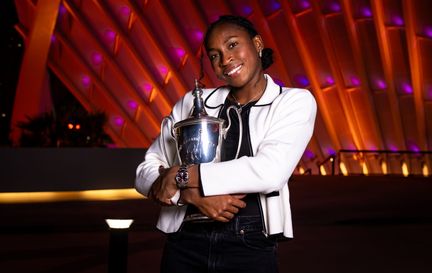In 2018 the WTA named its World No.1 Trophy for Chris Evert – a fitting tribute to the player who reigned supreme when computer rankings were introduced on November 3, 1975 and went on to hold the top spot for a total of 260 weeks. Since then, another 26 women have ascended to No.1 and 13 of them share with Evert the distinction of also being a year-end No.1, a feat she achieved five times.
While the official Chris Evert WTA World No.1 Trophy was designed to be presented to each new No.1 in perpetuity, the WTA also always intended to produce a replica for all former No.1s, to honor their achievements. So, when the Covid-19 pandemic put paid to a series of in-person celebrations in 2020, Evert jumped at the chance to take things virtual by hosting Zoom conversations with her fellow champions.
Happy birthday to WTA Legend @ChrissieEvert, who has been busy interviewing her fellow year-end World No.1s – stay tuned for series one, early in 2021!#Chrissie1on1 #WTAForTheGame pic.twitter.com/Kj7EUETWCo
— wta (@WTA) December 21, 2020
The first thought-provoking series of One-On-One With Chris Evert sees 10 former year-end No.1s open up about their rise through the ranks: Victoria Azarenka, Ash Barty, Lindsay Davenport, Simona Halep, Justine Henin, Martina Hingis, Angelique Kerber, Martina Navratilova, Monica Seles and Caroline Wozniacki. Evert also submits to an interview, conducted by her friend and ESPN colleague, Chris McKendry.
Where did these women find the passion and drive to devote their lives to tennis? Who inspired and supported them? How did they overcome challenges along the way? What did it mean to them to reach the summit, and what are their hopes for the future?
“From the outside, all these champions are different, but they all have the same qualities inside,” says Evert. “There are a lot of players out there that have the hard work ethic, focus, discipline and desire. But the great champions are especially driven. They are steely, they are resolute, they are hungry. They will do whatever it takes, sacrifice-wise… they are prepared to go the extra mile.”
That might mean skipping sleepovers with friends who live down the road or leaving family at an early age to train far away from home. While relishing the opportunity to explore the fascinating differences in each No.1 journey, Evert was especially keen to explore the recurring themes.
“To be No.1, three components have to come together at a very high level: the physical, the mental and the emotional," she observes. "You can’t just be mentally tough, you’ve got to be a great athlete as well. You can’t have all the tennis skills but have your mind scattered all over the place. You’ve got to be consistent, not a flash in the pan. It’s not about one big result – your mindset has to be in it for the long haul.
“Elite players know how to play within themselves, to the best of their abilities. They know the heights they can reach and they also understand their limitations. They have a very astute awareness of their game and they are clear thinkers. They can get themselves into a zone that lasts much longer than a single match.”
Famed for her powers of concentration, it’s probably no surprise that Evert, asked about the qualities that took her to the top, rates her mental and emotional strength above her underrated athletic prowess.
“I wasn’t the epitome of a fine-tuned, powerful Olympic champion,” she concedes. “That said, I had skills: balance, timing, anticipation. You could say I had the intangibles, and I think I can send a message to other girls that you don’t have to be the biggest, the strongest, the fastest. You can have other attributes and still work on the areas you need to if you want something badly enough.”
Game-wise, this translates to an affinity with Halep while on the psychological side of things, she recognizes the focus and intensity of Seles. “I was solid, I placed the ball, I had good pace, didn’t make errors – I can relate to Simona’s game. I wasn’t as creative as Hingis, who was just brilliant. On the mental side, I was pretty cool out there – I knew how to manage myself, manage my emotions and that’s something Monica did so well.”
The design of the Chris Evert WTA World No.1 Trophy is imbued with symbolism: a silver “star-map” tennis ball represents the tennis universe. All No.1s, past and present, are represented by a diamond in the sky, which heralds each champion’s mark on the sport. More than that, the finish of the star-map is hand stippled with thousands of tiny dots, to represent all of the women who have competed on the WTA Tour – as well as those yet to come.
Evert believes that when the dust settles on rivalries and competitive natures start to mellow, the WTA’s leading lights see their achievements in a wider context and come to appreciate they are members of a rare sisterhood – an iconic collective whose impact is felt beyond the sport.
“While you’re playing, you’re not giving much thought to other players, because it’s a very self-absorbed life,” she says. “To succeed at the highest level, you’ve got to think about yourself, and you can’t waste your emotional energy marveling at other champions.
“But I think after you retire and get away from the game, you can let down your guard and start to fully appreciate those you played against and those who came before. I do think there is a No.1 Club.
“The other thing is, when they become No.1, these champions all seem to gain in self-esteem and pride, which carries over to the rest of their lives, personally and professionally. Whether they appear as athletes to be confident and strong, or introspective and humble, the real blossoming often comes after they stop playing. That’s when you see the legacy.”
Stay tuned for One-on-One With Chris Evert on WTA channels in early 2021.





![Sara Sorribes Tormo d. [WC] Gao Xinyu 6-7(4), 7-5, 7-5, Beijing R1 (4:15). Sorribes Tormo led 5-1 in the third set, and held off a late comeback attempt by Gao to win the fourth longest match of the Open Era.](https://photoresources.wtatennis.com/photo-resources/2024/09/26/f4607c83-dcf9-4897-9b41-90ae8c384a35/Sorribes-Tormo-R1-ST-2.jpg?width=451&height=268)



